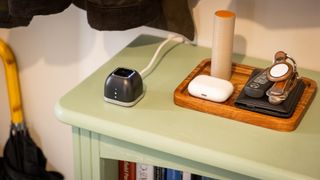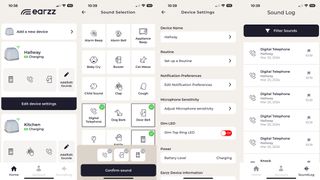The Earzz promises to be helpful around the home – especially for those who suffer reduced hearing – by using AI that listens out for specific sounds while ignoring speech. Notifications arrive promptly and the gadget is generally good at picking out sounds such as doorbells, buzzers and alarms; but the AI still requires some training to be perfect. It once mistook a smoke alarm for an «appliance beep» such as that of a microwave, and failed to hear both my washing machine and intercom buzzer – at least until the team at Earzz added the latter to their sound library, after which it worked perfectly.
Pros
- +
Compact, robust design
- +
Quick to set up and configure
- +
Broad range of alert options
Cons
- –
Notifications sometimes slow
- –
Poor Wi-Fi strength
- –
Sounds recognition AI not yet perfect
Why you can trust TechRadar We spend hours testing every product or service we review, so you can be sure you’re buying the best. Find out more about how we test.
Earzz: One-minute review
Smart Home Week
This is review is part of TechRadar’s Smart Home Week 2024, where we’re giving you all the latest news, tips and tricks to help you make the smart home of your dreams.
The Earzz sensor uses a microphone, smartphone app and AI to alert you to specific sounds, from a baby crying or a dog barking, to a doorbell, the beep of an appliance or broken glass. The result of a successful Kickstarter crowd-funding campaign, the Earzz is designed as much for the smart home (with IFTTT integration) as it is for helping carers respond to dependants and their needs in a reliable but anonymous way.
It offers around eight hours of battery life, so for most use cases you’re best leaving it plugged in with the included USB-C cable. You can set the Earzz to listen out for up to six of the 20-or-so available sounds. Phone notifications come through quickly, often in just a couple of seconds, and the app keeps a record of every time the device is triggered.

Imagination is key to getting the most out of Earzz. It can buzz your phone when there’s someone at the door, or let a care home worker know when a resident might have fallen. Add IFTTT integration and the Earzz could flash a smart light when your washing machine is finished.
The hardware is pretty basic, but it feels well made. It’s simple to set up and use, and there’s plenty of functionality to be explored. However, it doesn’t always perform as well as I’d hoped, and cannot always be relied upon to deliver accurate alerts promptly. A work-in-progress for now, but the AI will surely improve with training.

Earzz: Price and availability
- How much is it? £79.99 (about $100), plus subscription
- When is it available? Available now
- Where is it available? In the UK, with shipping to US available
At £79.99, or about $100, the Earzz isn’t cheap, especially when you factor in the subscription; the company advertises this as £7.99 a month but it’s billed at £95.88 annually (about $120). The high costs means this perhaps isn’t the sort of gadget you’d buy on a whim to experiment with in your smart home.
Instead, it’s aimed at people who are perhaps hard of hearing and need a way of being notified about things such as knocks at the door or a smoke alarm. Naturally, there’s a lot of value in such a product, but the high price means casual smart home fans might think twice.
Earzz: Specs
Swipe to scroll horizontally
| Row 0 – Cell 0 | Earzz | Row 0 – Cell 2 |
| Dimensions: | 5 x 5 x 4cm | Row 1 – Cell 2 |
| Connection: | USB-C, Wi-Fi, Bluetooth (the latter for setup only) | Row 2 – Cell 2 |
| Weatherproofing: | No, indoor only | Row 3 – Cell 2 |
| Battery life: | Approx. eight hours | Row 4 – Cell 2 |
| Smart home connectivity | IFTTT | Row 5 – Cell 2 |
| Scheduling function: | Yes | Row 6 – Cell 2 |
| Color options: | Black and white | Row 7 – Cell 2 |
| Subscription: | Yes, £95.88 annually | Row 8 – Cell 2 |
Should I buy Earzz?
Buy it if…
You’re a smart home fanatic looking for a new gadget
IFTTT support means the Earzz can control a huge range of smart home devices, from lights and plugs, to door locks, hearing aids and automated pet feeders. A routines function is also handy for scheduling when the Earzz alerts you and when it doesn’t.
You’re hard of hearing and need help with household alerts
This is really the whole point of the Earzz. It will alert you via your phone, tablet or smartwatch when something you can’t hear – a knock at the door, a microwave beeping, or the dog barking to be let out, for example – has happened.
